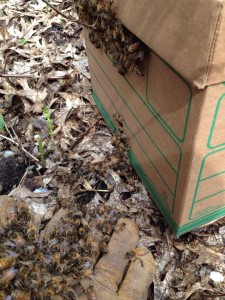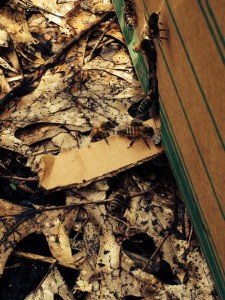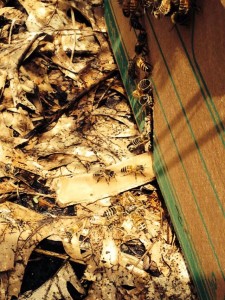How to Build a Swarm Box by Heather Wood:
These photos are of a sweet swarm from Kirk’s hive-see the bees walking into their new temporary box?
Materials include:
- Medium size cardboard box with lid (the kind used for filing documents works well).
- 6” x 4” scrap of window screen.
- Packing tape
- Box knife or serrated knife for cutting cardboard with.
First, fold out the box and lid. Second, tape all inside seems to prevent future bees from getting crushed in collapsible crevasses of cardboard. Next, use the knife to cut a 5” x 3” horizontal rectangle in the middle of one side of the box. This will be our screened window. Go ahead and tape the screen on the inside of the box’s window. There will be about a ½” of screen overhang around the window if we follow the above formula to an extent. Use the knife again for the three smaller cuts of an upside down “U” shape (90 degree angles) in the end of the box at the bottom edge to form a flap-door. The bottom edge crease of the box acts as a hinge. It is important that the door remains attached to the box.
When the time comes to catch your feral swarm of bees, you must act quickly. This springtime clump of bees is vital, and includes all the bees required to house a beehive, or tree (Read the Following Article for More Info on Swarms). It hangs on a branch with the queen, waiting to find a new home. The bees are gorged with honey under the influence of queen pheromone, and not apt to sting in swarm. (photo of my hand on my first swarm). I am including a link to an Earth Day IPod interview from 2015, and a couple other articles.
Podcast:
Article:
http://www.thurstontalk.com/2015/08/10/olyvbc/
Article:
http://www.thurstontalk.com/2014/08/03/evergreen-bee-sanctuary/
Differences Between Natural and Conventional (beekeeping) by Heather Wood:
Our Goal is to step far away from Conventional beekeeping, in hopes of restoring honey bee populations. I will point out some practical differences between Natural Beekeeping and Conventional. I may list them polar opposite from one to the other, but keep in mind there is a spectrum of many shades of beekeeping to draw from.
Stepping away from conventional beekeeping means giving up our affinity for manicured lawns and to chemical laden plants. Imagine a life without systemic pesticides-our next generation demands it! Imagine zero fertilizers, and zero GMOs, imagine never seeing pesticides on the shelves at our favorite nursuries. We don’t need manicured lawns and grasses to survive, what we need are miles of urban farms to feed urban bees and people. One name for this idea, is hyper-local. Make a place where you are. It is easy to organize neighbors, public speaking, and to hand out flyers of information.
Natural Bee Living (Bee-Cetric)
- Zero Chemical Use
- Zero GMO
- Urban Farms, hyper-local Lifestyle
- Authentic and local bees
- The honey bees propagate by growing authentic queens, and just before she hatches, the older queen with about half the colony organizes their leave to find a new home. Natural queens are raised from day 1 in a vertical orientation and fed a special diet for each of her 16 days in cell. As Gunther Hauk explains in Toward Saving the Honey Bee: “Swarming is a powerful and vibrant expression of a healthy, well-functioning bee colony.” (Hauk p39.1). The bees about to leave, gorge themselves with stores of honey for their new home, and the queen emits a strong dose of pheromone for coalescence. Like a giant drop of water forming from a mist, the bees swoop out of the hive in “a loose vortex” (Hauk). Before the bees find a home, they must wait on a nearby branch or other stationary fixture from where they send out scouts. The scout bees find housing options the colony will vote on to decide where sounds best.
- Leave the Honey Stores for the Bees to Live on Throughout the Winter Months.
- Hands Off
- Bees are Allowed to Draw Their own Comb
- Bees are Allowed to Grow as Many Drones as they Deem Necessary
This is a short list, that needs expanding on-I will continue to edit and add to this.
Read about the first honey bee in North America:
 Published on: July 28, 2009 byKathy Keatley Garvey-The Bug Sqaud
Published on: July 28, 2009 byKathy Keatley Garvey-The Bug Sqaud
![[SCM]actwin,-226,-251,814,49; 6/29/2014 , 5:11:17 PM](http://urbanevergreenbeesanctuary.com/wp-content/uploads/2014/06/nz-herald1.jpg)
A word from Element Magazine in The New Zealand Herald on the disasterous choice of Neonic pesticides and the extreme destruction caused.
click here
![[SCM]actwin,-226,-251,814,49; 6/29/2014 , 5:11:17 PM](http://urbanevergreenbeesanctuary.com/wp-content/uploads/2014/06/different-colors1.jpg)
Why are my bees different colors? Interesting article at Honey Bee Suite.
click here


